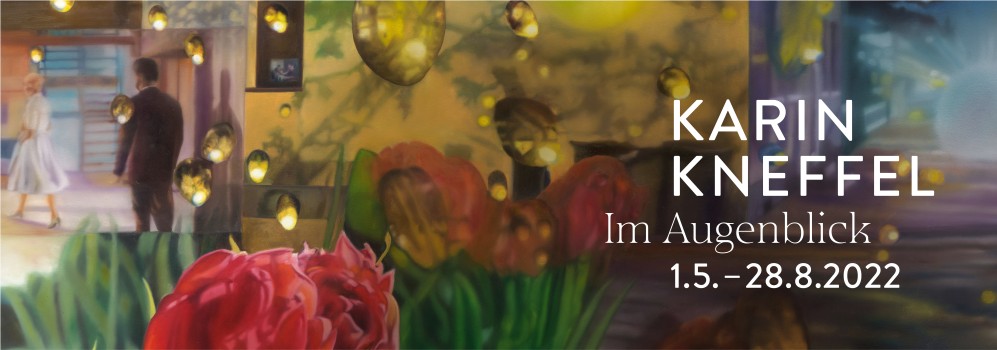QR-Code
Audioguide auf Deutsch
Audioguide zur Ausstellung »Karin Kneffel – Im Augenblick«, gesprochen von Schauspielerin Anna Schudt. Redaktion: Stefanie Pütz
00 - Einführung
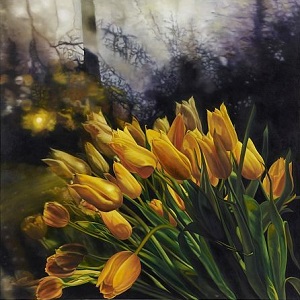
01 - Ohne Titel, 2016
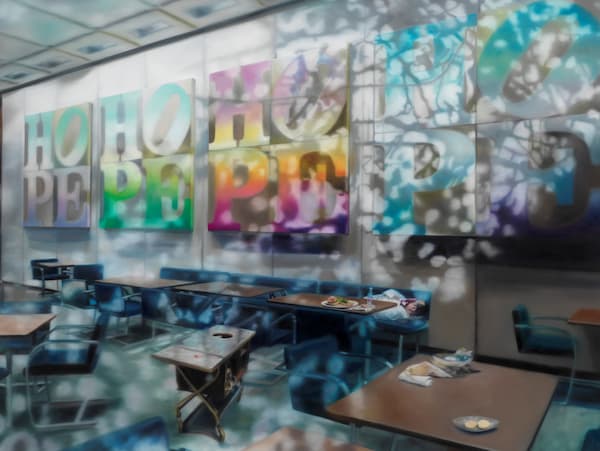
02 - Ohne Titel, 2009
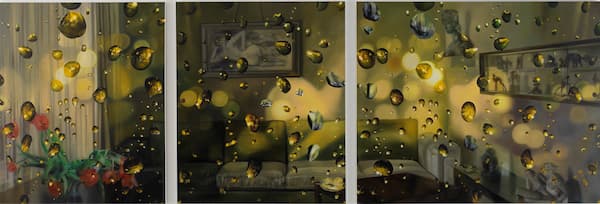
03 - Ohne Titel, 2021
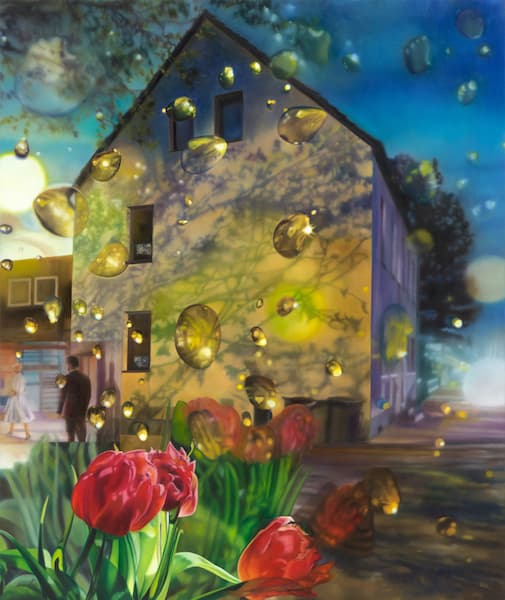
04 - Ohne Titel, 2019
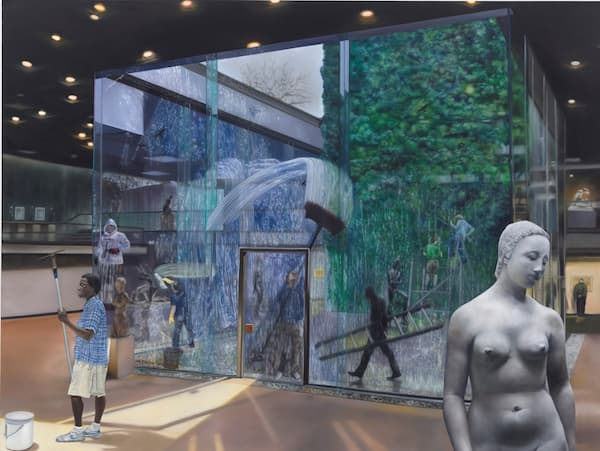
05 - Ohne Titel, 2015

06 - Ohne Titel, 2007
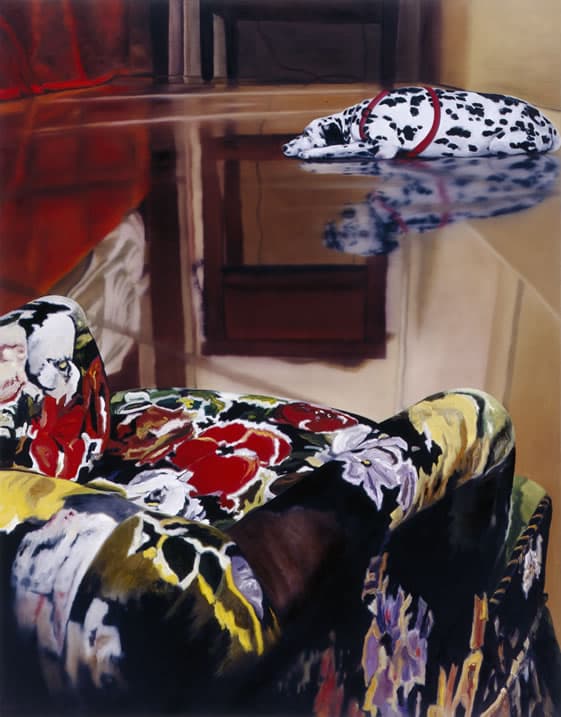
07 - Ohne Titel, 2016
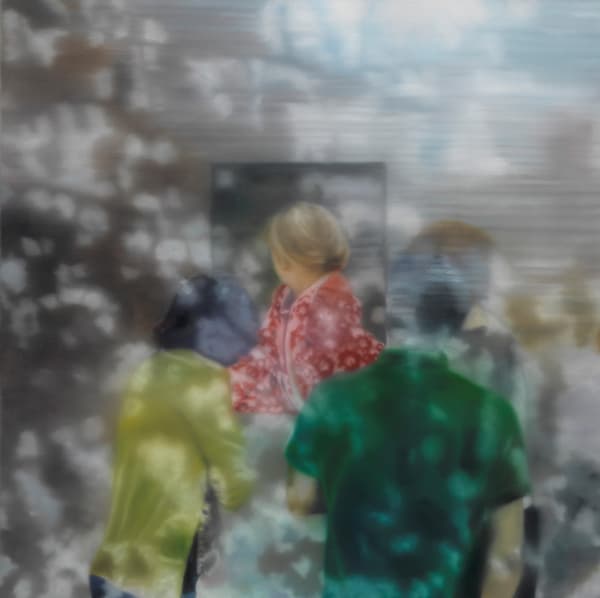
08 - Ohne Titel, 2011
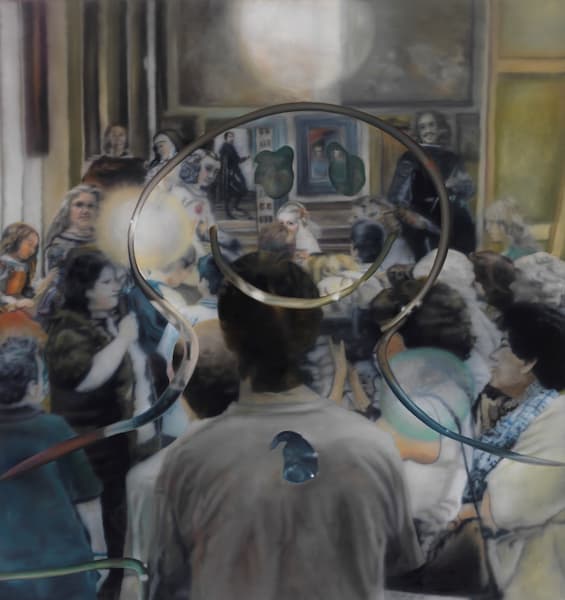
09 - Ohne Titel, 2014

Exhibition Texts in English
00 - Introduction

Introduction
Welcome to the exhibition “Karin Kneffel – At the Moment”. The show gathers around 80 oil paintings and watercolours of the last 20 years and provides you with poignant insight into the complex work of the artist.
Karin Kneffel was born in 1957 in Marl. She studied painting at the Kunstakademie Düsseldorf in the 1980s. Her teachers were Johannes Brus, Norbert Tadeusz and Gerhard Richter, who took her on as a master student. Kneffel became internationally known with her humorous animal portraits, large-format fruit still lifes and complex interior views. Following a professorship at the Hochschule für Künste in Bremen, she has taught at the Akademie der Bildenden Künste in Munich since 2008. She now lives and works in Düsseldorf and Munich.
Kneffel combines representationalism and optical irritations in her works in her own very special way. At the nine stations of the audio guide, you will be introduced to important themes and motifs that have occupied the painter for years: puzzling views of interiors and exteriors, in which that already existing and the everyday are dissociated.
Everything appears to be within one’s grasp, but Karin Kneffel’s painting always contains incongruities and fractures. Past and present, reality and fiction transition fluidly into one another. Her works invite the viewer to a special experience of seeing – in which one must at all times expect to be deceived.
01 - Untitled, 2016

Karin Kneffel, Untitled, 2016, Oil on canvas, 180 x 240 cm
We are looking into an almost empty restaurant. Only a waiter is taking a break on a bench to the rear and seems to have fallen asleep. He has placed his tie over his eyes to keep out the light. Karin Kneffel observed the scene in New York and captured it in this painting. The location of the action: the Four Seasons Restaurant in the Seagram Building. Ludwig Mies van der Rohe designed and completed the skyscraper in cooperation with Philip Johnson in 1958. A good 50 years later, Karin Kneffel visited the city to prepare an exhibition. She discovered the building and entered the restaurant, the furnishings of which adopt elements relating to the four seasons. She visited it at various times of the day and was fascinated by the atmosphere of the rooms.
A large work of art in four parts hangs on the wall above the sleeping waiter: “The Four Seasons of Hope” by Robert Indiana. However, it is only partially recognisable: a dense play of shadows lies like a pattern on the work and the chairs and tables in the foreground. The branches and leaves of the trees found in the interior of the restaurant as decoration seem to be delineated in the changing light.
In other paintings, Karin Kneffel creates the illusion of a fogged-over pane of glass, which appears to have been written on with a finger. Quotes of the two architects of the building can be read: “I have to have a wall behind me” from Mies van der Rohe and “Butter never crossed my mind” from Philip Johnson.
02 - Untitled, 2009

Karin Kneffel, Untitled, 2009, Oil on canvas, 2 x 180 x 150 cm, 1 x 180 x 220 cm
Karin Kneffel occupied herself pictorially with Haus Esters and Haus Lange in Krefeld for an exhibition in 2009. The architect Mies van der Rohe had designed the buildings in 1927/28 in Bauhaus style as homes for the silk manufacturers Hermann Lange and Dr Josef Esters, who were friends with one another.
For several decades now, the two homes have been used as exhibition locations of the Krefeld art museums for modern and contemporary art and are thus open to the public. However, the architectural concept of Mies van der Rohe with the open series of rooms and the window façades is oriented to the private needs of the clients. This residential character is still quite tangible for Karin Kneffel. Her research also encompassed the original furnishings and the former art collection of the industrialist families. She discovered photos from the 1930s in the archives. Important individual works of art can be identified. However, she also found quite stuffy furniture, which stood in a strange contrast with the modern architecture of the buildings.
In this triptych, Karin Kneffel takes a look into Haus Lange, or more precisely, into the room of the lady. The furnishings we can see correspond with those found in the historical photos, and the artworks of the time also appear in her painting: works by Wilhelm Lehmbruck, Renée Sintenis and Hugué Manolo.
The red tulips on the table in the foreground, the sliced lemon and the smouldering cigar have been added. The artist also added individual animal sculptures by Renée Sintenis in the display case to the right. Everything appears harmonious and plausible – and is at the same time fiction.
Fiction also in another respect: the artist only had access to black and white archive photos of Haus Lange. She made use of an artifice to create the colour scheme: she covered the entire painting with painted drops of water, so that the impression arises as if one were looking through a wet pane of glass – a pane that refracts the incoming light and lies like a colour filter over the scenery. "Such a windowpane always has a colourfulness, whether at night or during the day, some kind of bluish light”, the artist explains. She also enjoys the voyeuristic moment: "When one looks through a pane, one has the feeling of doing something forbidden. One infiltrates an intimate sphere", she says.
03 - Untitled, 2021

Karin Kneffel, Untitled, 2021, Oil on canvas, 180 x 150 cm
Karin Kneffel grew up in the Ruhr region. Here one finds the typical worker settlements of the post-war era: blocks of flats standing next to one another in rank and file, plain and grey, with a few small windows. The artist dedicated a series of paintings to such Ruhr region buildings.
Here we look through a windowpane at a building in the evening light. Trees throw delicate shadows onto the walls; the sky frames the building with brilliant shades of blue and the large drops on the pane have an almost golden shine. The effects lend the simple architecture a particular charm. "I very much liked that the buildings all at once became worthy of painting as a result", Karin Kneffel says.
And they awaken memories of the 1970s. One looked into the neighbourhood and principally saw oneself: the same building, the same television programme. The streets emptied when a film like one from Alfred Hitchcock was playing. Karin Kneffel captures this slightly ghostly atmosphere: the only people one sees in her painting are actors in a film, who are reflected in the wet windowpane through which we are looking.
Right up front is a bouquet of tulips as a red accent, which is also reflected in the pane. This produces an additional level in the painting, which lies in front of the pane: unlike the rest, the tulips are represented in sharp contrast and appear to be within one’s grasp. They are found in front of the window, through which we are looking at the other building. Just like the television, of which we see only the reflection in the pane. The drops on the pane create a distance from the pictorial space. The artist compares the play with the drops of water with an aquarium: "As if one were oneself floating in a liquid and exhaling, so that bubbles rise”, according to Kneffel
04 - Untitled, 2019

Karin Kneffel, Untitled, 2019, Oil on canvas, 180 x 240 cm
We are looking into the Lehmbruck Museum in Duisburg. A glass cube stands in the atrium. Several window cleaners are cleaning it. They foam and wipe or squeegee the panes. Several of them are standing on ladders, others on the floor, while several sculptures can be recognised vaguely between them.
One thing is unusual about this work by Karin Kneffel: glass surfaces are being cleaned here so that one can supposedly see things more clearly. Nonetheless, here too, the panes provide for breaks in perspective and irritations.
The window cleaners bring motion to the painting. The focus is on their routine work, and thus on the profane fact that panes of glass need to be cleaned – even when they belong to an artful cube that is part of the museum architecture. At the same time, the rough wiping movements of the men are reminiscent of an expressive painterly air. A sculpture by Wilhelm Lehmbruck can be seen at the very front of the painting: the “Große Stehende“ (standing female figure) – a nude woman with closed eyes, completely self-engrossed. The cool paleness and inactivity of the classic figure provides a stark contrast with the routine movements of the window cleaners.
The museum building was designed by the architect Manfred Lehmbruck, by the way. He was the son of the sculptor Wilhelm Lehmbruck and was influenced by the architecture of Ludwig Mies van der Rohe.
05 - Untitled, 2015

Karin Kneffel, Untitled, 2015, Oil on canvas, 90 x 70 cm
Two brushstrokes, thrown onto the canvas with a quick gesture – the red cross in this painting seems virtually pastose. Pastose means: the paint is applied thickly and relief-like. However, those who look closely will discover: the cross is painted cleanly and fine, just like the rest of the painting.
Following her exhibition in Krefeld, Karin Kneffel dedicated herself to the fund of black and white photographs with which the collection holdings are documented. For this painting too, Kneffel took an archive photo from the 1930s as a reference. We are looking into Haus Lange, this time into the dining room. On the right side we see a painting by Marc Chagall, "The Holy Cabman".
Another painting hangs on the left wall – the large red cross conceals it. The artist thus points out that she was unable to identify the work in the photo. We are in this way provided insight into her research work – and the obstacles she met with when viewing the found material.
The red cross had already served other artists as a means of expression – to emphasise or comment on something. For example, in Willi Baumeister’s poster for the Werkbund exhibition in Stuttgart in 1927. Here, the photo reproduction of a middlebrow interior has been crossed through in red in order to explain the turning away from the staid style in favour of modernity. Roy Lichtenstein also painted red brush strokes in the 1960s, thus referring to his break with the traditions of painting. The reduction to individual strokes is also found in Gerhard Richter’s commissioned work from 1979 with the title “Two Yellow Strokes”.
06 - Untitled, 2007

Karin Kneffel, untitled, 2007, oil on canvas, 190 x 150 cm
A dalmatian is lying in an interior. Its snout rests between its front paws, as if it were sleeping. An armchair with a colourful, large floral pattern stands in the foreground. A curtain material can be recognised to the top left, in the same red as a few blossoms on the armchair. Everything in this room fits; even the dog harmonises in its colouring with the seating.
Karin Kneffel paints this interior clearly and distinctly, virtually photorealistically. Nonetheless, we discover incongruities when we look more closely: there is no carpet on the floor, no parquet and no tiles to be seen. Instead, a mirrored surface that looks like water or very shiny ice. However, it might be a perfectly polished floor. The dog is lying on this smooth surface, its head on the floor. However, its head is raised and it watches us alertly in the reflection. An unreal, surreal moment, because this does not match up. Just as unexplainable is the nature of the floor.
The work is part of a series of interior views, which Karin Kneffel began in 2003. The artist here deliberately focuses on motifs that are today seen as somewhat outdated and decorative in painting: sleeping dogs, flowers, patterned armchairs, richly ornamented wooden tables. However, in Kneffel’s case, the beautiful interiors do not create a cosy atmosphere, but instead seem too cool and too uncanny.
Viewers should remain at a distance from her paintings, as Karin Kneffel has stated several times. And she is successful in this in the most varied ways. She generates a feeling of unease in another work from the series. A television stands next to a bed, on the screen of which a woman with a hunting rifle can be seen – a scene from a film with Vico Torriani. Not far from the barrel of the rifle, but outside of the television is the skin of a cheetah on the floor of the room. A decorative rug – if it was not for the eyes of the animal, wide open in terror.
07 - Untitled, 2016

Karin Kneffel, Untitled, 2016, Oil on canvas, 80 x 80 cm
A girl turns her head back, her blonde plait is hidden in a floral bathrobe, her face cannot even be discerned. “Betty” from 1988 is one of the most famous paintings in contemporary art. Gerhard Richter painted it from a photo of his daughter, who was around ten years old when it was taken. Her clothing and hair seem so realistic that many people think the painting is a photograph. A sensational representation at the time, as representational painting was viewed as obsolete. “I was totally perplexed, found it to be incredibly untoward and actually even cheekier than what the others were doing”, Karin Kneffel says of “Betty”. She liked the painting, and it inspired her to consider the meaning of painting.
In 2014, Kneffel, in the meantime a university professor, travelled with her students to Basel for the major Richter retrospective. “Betty” has in the meantime become world-famous and has been printed on countless posters and postcards – it seems to exert an enormous attraction. In the exhibition, Kneffel now observed how three of her students examined the painting from all sides, as if they could in this way reveal its secrets. She captured this moment in a series of paintings, as a commentary on the great fascination emanating from “Betty”.
Karin Kneffel chose a square format for her painting. Richter’s painting forms the centre, the students stand in front of it and consider “Betty” with heads turned at all angles. As in other paintings, in which Kneffel cites works of other artists, she works with distancing effects. Here she plays with light and cast shadows. They lie like a veil over the entire painting, so that everything seems slightly blurry.
In another series, Karin Kneffel occupied herself with another familiar motif of Gerhard Richter: “The Candle” from 1982. Kneffel was invited to explore the work artistically on the occasion of a thematic exhibition in the Museum Frieder Burda in Baden-Baden. Here, her main concern is not to imitate her former teacher – considering that she had been painting for 40 years and had herself been a university professor for more than 20 years. Karin Kneffel used this pictorial citation to reflect on more fundamental matters. She shows what arises from an involvement with painting, the extent to which a work of art can stimulate reflection and how it can still cause astonishment even years after an initial encounter.
08 - Untitled, 2011

Karin Kneffel, Untitled, 2011, Oil on canvas, 180 x 170 cm
“I just thought I would like to paint the painting.” This is what Karin Kneffel says about the origin of this work.
Flashback: Karin Kneffel is in Madrid, in the Museo del Prado, standing in front of a famous work of art: “Las Meninas” – the ladies-in-waiting – by Diego Velázquez, which was created in the mid-17th century. “Las Meninas” shows a scene in the palace studio of the artist. The central figure is the young daughter of the Spanish king with her lady-in-waiting. Next to her, the artist Velázquez stands in front of the easel with a brush and paint palette in his hands. Two figures are vaguely recognisable in the background, surrounded by a dark, broad frame: King Philip IV and his wife Maria Anna. Is this a reflection of the two, who are being portrayed by the painter at the moment? Or is that a painting of the royal couple hanging there? The work by Velázquez plays with these aspects of perception, illusion and reality, and has therefore been discussed in art historical research for many years.
Dozens of people are always found bustling in front of it in the Prado every day. However, does anyone talk about the painting, the colours and the composition? Is the painting genuinely appreciated? Karin Kneffel approached the work of Velázquez with these questions in mind. She mirrors it – and in doing so adds another level of complexity to her painting. Perhaps she is in this way also referring to the question of the mirror in the representation of Velázquez, and thus to the discussion, which often keeps people from truly immersing themselves in the painting.
The many museum visitors in the work of Karin Kneffel also make it impossible to see “Las Meninas” in its entirety. Those who look at Kneffel’s painting are thus looking at viewers looking at a work of art – and find themselves at the fringes of the group of visitors. Finally, the artist adds a big smiley, as if someone had drawn a face on a damp mirror with a fingertip – with eyes, mouth, neck and suggestions of arms. And where is the royal couple? One can recognise it, somewhere between all the other people.
09 - Untitled, 2014

Karin Kneffel, Untitled, 2014, Watercolour, 18 x 30 cm
We find ourselves in a Catholic church in Spain. Those who wish can confess there, and this in one of three languages: Spanish, Italian or English. A handwritten sign, visible in the painting, informs about this service. We see a priest sitting in the semi-open confessional and listening to someone. The person confessing remains invisible. Only her black shoe is vaguely recognisable.
The work is part of a series from 2014. Karin Kneffel circles the confessional from several perspectives: sometimes she illustrates a detail, sometimes a larger excerpt. In this scene, she guides the gaze to the motionless priest. His head is inclined forward, his eyes are closed, his white sleeve radiates from the centre of the painting. Adjacent, we see people with wafting coats, passing through the church with big steps – probably tourists seeing the sights. A section of the church architecture can also be discerned, onto the walls of which warm sunlight falls. All this in harmonious colourfulness: blue, purple, violet, yellow, ochre, gold.
Karin Kneffel uses the technique of watercolour painting here. This presents a special challenge for many artists because corrections to the painting are hardly possible. However, the watercolours of Karin Kneffel differ little from her oil paintings in terms of their complexity. She chooses similar motifs and is also able to place several layers on top of one another with watercolour paints, and thus to create sources of irritation.
The semi-open confessional, the suggested confessional situation – the artist once again chooses the motif of the hidden, the mysterious, this time in a church context. Here too, she comments on her own painting with a deceptively realistically painted stick man, which appears as if drawn on a fogged-over pane with a finger. The corners of its mouth are turned downward and, due to the drops running down beneath its eyes, it looks as if its face were tear stained.


